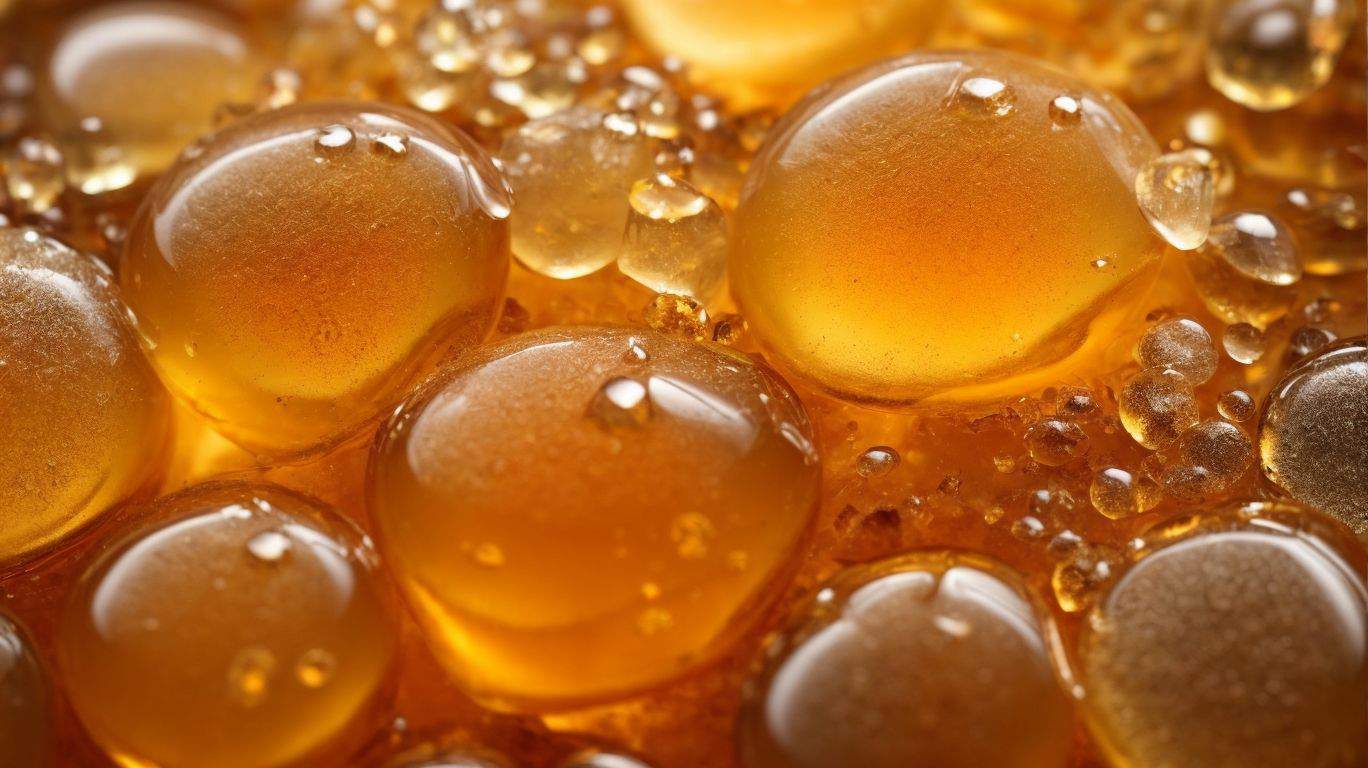Did you know that your jar of delicious, golden honey may eventually turn into a solid, grainy block? This may seem concerning, but rest assured, it is a completely natural process.
In this article, we will delve into the fascinating science behind why honey crystallizes and how it affects its quality. So, let’s get ready to unclog the mystery of this common concern!
What Causes Honey To Crystallize?
Honey is a beloved natural sweetener, but have you ever wondered why it sometimes turns into a solid mass? In this section, we will discuss the different factors that contribute to the crystallization of honey.
From the natural sugars present in honey to external temperature changes and impurities, we will uncover the science behind this fascinating process.
So let’s dive into the causes of honey crystallization and better understand this common occurrence.
1. Glucose And Fructose
Glucose and fructose are the two main components of honey that contribute to its crystallization process. When honey contains a high ratio of these two sugars, it is more likely to form crystals.
This is because glucose molecules have a lower solubility in water compared to fructose, causing them to come out of solution and form crystals.
Additionally, the presence of pollen and impurities in honey can also act as nuclei for crystal formation. However, even when crystallized, honey is still safe to eat and retains its nutritional value.
On a personal note, I once discovered a jar of crystallized honey in the back of my pantry. Instead of discarding it, I decided to give it a try.
After warming it in a water bath, the honey returned to its liquid form, revealing a rich, golden color and a smooth, sweet taste.
It was a pleasant surprise to find that the crystallized honey was still perfectly edible and delicious.
Since then, I have come to appreciate the natural process of crystallization and the unique texture it brings to my honey.
2. Temperature Changes
Temperature changes can cause honey to crystallize.
3. Pollen And Other Impurities
Pollen and other impurities can cause honey to crystallize. Here are some steps to explain the process:
- Bees collect nectar from flowers, which contains tiny pollen grains.
- During the honey-making process, some of these particles can become trapped in the honey, including pollen and other impurities.
- Over time, these particles act as a seed for the crystallization process, causing the honey to solidify.
To prevent crystallization:
- Use a fine mesh strainer to remove pollen and other impurities from the honey.
- Store honey in a cool, dry place to slow down the crystallization process.
- Avoid exposing honey to temperature changes, as this can speed up the crystallization process.
By following these steps, you can maintain the liquid consistency of your honey and enjoy it for a longer period.
Is Crystallized Honey Still Safe To Eat?
Have you ever wondered why honey sometimes turns into a solid, grainy texture? This natural process, known as crystallization, can make some people question if it is still safe to consume.
As long as your honey is not fake, you should not be worried.
In this section, we will discuss the safety of eating crystallized honey and the benefits it can offer.
From its nutritional value to its extended shelf life, there are several reasons why crystallized honey should not be overlooked. Let’s delve into this topic further.
- It Is Still Nutritious
- It Has A Longer Shelf Life
- It Has A Longer Shelf Life
How To Decrystallize Honey?
Have you ever reached for your jar of honey, only to find it has crystallized into a thick, grainy consistency? Don’t worry, you’re not alone.
In this section, we will discuss the best ways to decrystallize honey and restore it to its smooth, liquid state.
We will cover three methods: the warm water bath, microwave method, and stove top method. Each method offers its own unique benefits, so let’s dive in and find the perfect solution for you.
1. Warm Water Bath
To decrystallize honey using a warm water bath, follow these steps:
- Fill a container or sink with warm water.
- Ensure the water temperature is not too hot, as it can degrade the quality of the honey.
- Place the jar of honey into the warm water bath.
- Leave the jar in the water for about 15-20 minutes.
- Gently stir the honey every few minutes to help distribute the warmth.
- Once the honey has liquefied, remove the jar from the warm water bath.
- Make sure to dry the jar before storing the honey.
Using this method, the warm water bath will gently heat the honey and dissolve any crystallized particles, restoring it to its liquid state.
2. Microwave Method
To decrystallize honey using the Microwave Method, follow these steps:
- Place the crystallized honey in a microwave-safe container.
- Set the microwave to low power or the defrost setting.
- Heat the honey in short intervals, around 30 seconds at a time, to avoid overheating.
- After each interval, stir the honey to distribute the heat evenly.
- Continue microwaving and stirring until the honey reaches a liquid consistency.
Remember to be cautious when handling hot containers and to use microwave-safe utensils while following this method.
3. Stove Top Method
To decrystallize honey using the stove top method, follow these steps:
- Fill a saucepan with water and place it on the stove.
- Bring the water to a gentle simmer.
- Remove the lid from the jar of crystallized honey and place it in the saucepan.
- Allow the honey to warm up gradually, stirring occasionally.
- Once the honey has melted and become liquid again, remove the jar from the saucepan.
- Let the honey cool down before using or storing it.
To prevent honey from crystallizing in the future, store it properly in a cool, dry place, add a small amount of lemon juice or vinegar to make it more acidic, or use a honey warmer to keep it at a consistent temperature.
By following these steps, you can easily decrystallize honey using the stove top method and prevent it from happening again. Enjoy your smooth and liquid honey!
Ways To Prevent Honey From Crystallizing
Have you ever opened a jar of honey, only to find it has turned into a grainy, solid mass?
This natural process, known as crystallization, can be a hassle for honey lovers. But fear not, there are ways to prevent this from happening.
Let’s discuss three methods to prevent honey from crystallizing: proper storage, adding an acidic ingredient, and using a honey warmer.
1. Store Honey Properly
Properly storing honey is crucial to prevent crystallization and maintain its quality over time.
- Store in a cool, dry place: Keep honey away from heat and humidity to prevent moisture absorption.
- Airtight container: Seal honey tightly in a glass jar or container to prevent exposure to air.
- Avoid direct sunlight: Store honey in a dark place to prevent UV rays from affecting its composition.
- Adequate temperature: Maintain a consistent temperature between 50-70°F (10-21°C) to prevent crystallization.
Ancient Egyptians stored honey in clay jars, discovered in the tombs of pharaohs, dating back over 3,000 years.
2. Add An Acidic Ingredient
Adding an acidic ingredient can help prevent honey from crystallizing. Here are some steps to follow:
- Choose an acidic ingredient such as lemon juice or vinegar.
- Measure out a small amount of the acidic ingredient based on the amount of honey you want to treat.
- Gently heat the honey in a double boiler or microwave until it becomes liquid.
- Stir in the measured amount of the acidic ingredient until well combined.
- Allow the honey to cool and store it in a tightly sealed container.
A beekeeper once discovered that by adding a small amount of apple cider vinegar to their honey, they were able to prevent it from crystallizing.
This simple technique allowed them to enjoy smooth and spreadable honey all year round.
3. Use A Honey Warmer
Using a honey warmer is an efficient method for decrystallizing honey. Here are the steps to properly use a honey warmer:
- Place the container of crystallized honey in the honey warmer.
- Set the temperature to a low heat setting to gently warm the honey.
- Allow the honey to warm for several hours or until it becomes liquid again.
- Stir the honey occasionally to evenly distribute the warmth and expedite the decrystallization process.
- Once the honey is completely liquid, remove it from the honey warmer and store it in a cool, dry place.
Using a honey warmer is a straightforward and convenient way to restore crystallized honey to its original smooth consistency, making it easier to pour and consume.
Frequently Asked Questions
1. Why does honey crystallize?
Honey crystallization is a natural process that happens when the liquid honey transforms into a semi-solid state. This happens due to the natural composition of honey, which contains a high concentration of sugar and low water content.
2. Is crystallized honey safe to eat?
Yes, crystallized honey is completely safe to eat. In fact, some people prefer the texture and taste of crystallized honey. It does not affect the nutritional value or quality of the honey in any way.
3. Can I make crystallized honey into liquid again?
Yes, you can easily turn crystallized honey back into a liquid state. Simply place the jar of honey in a warm water bath and stir until the crystals dissolve. However, keep in mind that honey will eventually crystallize again.
4. What causes honey to crystallize faster?
The speed of crystallization of honey depends on several factors, including the type of flowers the nectar was collected from, the temperature at which it is stored, and the presence of pollen or other impurities in the honey.
5. Does the color of honey affect its tendency to crystallize?
Yes, research has shown that lighter colored honey, such as clover or wildflower, has a higher tendency to crystallize compared to darker honey like buckwheat or manuka.
6. Can I prevent honey from crystallizing?
While it is natural for honey to crystallize, you can slow down the process by storing it at room temperature, away from direct sunlight. It is also advised to store honey in airtight containers to prevent moisture from seeping in, which can accelerate crystallization.
I’m a Manuka honey enthusiast and creator of Manuka Honey Organic, a blog where I share my journey with authentic Manuka honey from New Zealand. I want everyone to learn about the healing powers of Manuka honey.



